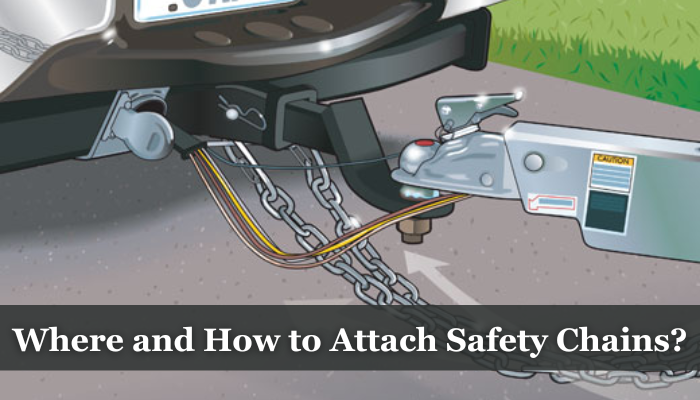This post may contain affiliate links which means I may receive a small commission for purchases made through the links. Learn More
Safety chains are an essential component of towing because they make sure that the trailer remains connected to the tow vehicle in case of a hitch failure. However, many people are unsure of where and how to properly attach safety chains.
It won’t be wrong to say that safety chains give you peace of mind that if your hitch fails, you won’t see an accident as safety chains are there to protect you. They act as the additional security layer that protects you in the worst case.
In this blog post, I will cover everything you need to know about safety chains, including the proper locations to attach them to your vehicle, the steps for secure attachment, and the different types of chains available. So let’s get started!
Related Article: How Do Hitch Locks Work?
What are Safety Chains and Why are they Important?
Safety chains are cables that connect the trailer to the tow vehicle. They act as a backup or an additional security layer in case the hitch fails, preventing the trailer from becoming detached and potentially causing an accident.
Look, when you tow a trailer with your vehicle with a hitch, then sometimes the hitch can break due to the extreme weight of the trailer or your reckless speeding. So, there must be something that could protect you if the hitch breaks.
In this case, these safety chains act as additional security for you. With the proper safety chain, even if your hitch breaks due to any reason, then the safety chains will protect you.
Where to Attach Safety Chains?
Placing the safety chains in are right place is very important for its effective functionality. These chains should always be attached to the frame of the vehicle.
The reason for attaching the chains to the frame of the vehicle is that this is the strongest point that provides the most secure connection. Avoid attaching the chains to the bumper or other parts of the vehicle that are not designed to withstand the weight of the trailer.
It’s also important to ensure that the chains are not dragging on the ground. This can cause damage to the chains and create a safety hazard for other drivers. To avoid this, make sure the chains are not too long and that they are attached at the appropriate height on the vehicle.
Practical Tip: While attaching the safety chains, proper tightness is the key. However, don’t tighten the chain too much. Balance is a must. The chains should be too tight, and also not too loose and cause problems.
How to Attach Safety Chains?
So, we have come to our main topic which is how to attach a safety chain. Although attaching safety chains is a simple process, it’s important to do it correctly to ensure a secure connection. Follow these steps to properly attach your safety chains:
Step 1 – Choose Right Safety Chain
It’s important to use safety chains that are appropriate for the weight and size of your trailer. Safety chains come in different strengths and lengths, and you’ll want to make sure you choose ones that can support the maximum gross weight of your trailer. I recommend you look for those safety chains that are labeled with their weight rating, and compare that rating to your trailer’s weight.
Step 2 – Attach the Safety Chains to the Trailer
Most trailers have designated attachment points for safety chains. These attachment points are typically located near the trailer’s hitch or tongue. Look for metal loops or brackets where the safety chains can be attached. If you can’t find any attachment points, then I suggest you talk to the manufacturer of your trailer and get the information about the attachment points.
Step 3 – Cross the safety Chains underneath the trailer’s tongue.
Once the safety chains are attached to the trailer, cross them underneath the trailer’s tongue. It will prevent the tongue from hitting the road if it becomes detached from the hitch. When you cross the chain underneath the tongue, then it helps distribute the weight of the trailer more evenly across both chains, which can help prevent one chain from bearing all the weight if there’s a problem with the hitch.
Step 4 – Attach each end of the safety chains to the tow vehicle’s hitch
I hope that you have successfully crossed the chain under the tongue, now it is time to attach each end of the safety chains to the designated attachment points on the tow vehicle’s hitch. Almost all the hitches have metal loops or brackets where the chains can be attached.
Yous should make sure the chains are securely fastened and won’t come loose during towing. When you leave the chain unchecked, then chances are high that they will loosen and start dragging on the road.
Step 5 – Adjust the length of the safety chains
Once the safety chains are attached, adjust their length so they’re not too loose or too tight. You want to have enough slack in the chains to allow for turns, but not so much that they drag on the ground. A good rule of thumb is to leave about a foot of slack in the chains. This will allow the chains to absorb any sudden jolts or movements during towing without being too loose.
Step 6 – Test the safety chains
By following the above-mentioned steps, you’ll finally successfully attach the safety chains. Now it is time to check if the attached chains are working fine. You can test the safety chains by pulling on them to make sure they’re securely attached. Give each chain a good tug to make sure it won’t come loose during towing. If the chains are loose, adjust them accordingly.
Point to Remember: You will need to tighten the chains so that there is no slack left. This will ensure that the chains are taut and will not drag on the ground.
Types of Safety Chains
So, you have now learned how you can attach the safety chains. But I won’t let you go as I have some more information about the type of these chains. There are two main types of safety chains: straight chains and twisted chains.
- Straight chains are the most common type of safety chain and are the easiest to use. They are made of a single piece of chain and are attached to the vehicle and trailer using hooks. They are strong and durable and can be used with most types of vehicles and trailers.
- Twisted chains are made of two or more pieces of chain that are twisted together. They are more flexible than straight chains and can be used in tight spaces or when the vehicle and trailer are not perfectly aligned.
It’s important to choose the right type of safety chain for your specific towing situation. If you’re unsure which type to use, then you must read the user manual of your trailer so that you get the best of your knowledge from the manufacturer.
Frequently Asked Questions
You should always check your safety chains before each trip and periodically during the trip to ensure that they are tight and secure.
No, you should only use chains that are specifically designed for towing. These chains are made from high-strength materials and are rated for the weight of your trailer. Use the chain that is rated for your trailer weight.
No, ropes are not recommended for safety chains. Ropes are not as strong as chains and can stretch or break under the weight of the trailer.
Yes, but I recommend you use two safety chains for added security. In case one chain fails, the second one will provide a backup connection.
Conclusion
Safety chains provide an extra layer of protection in case of a hitch failure. Choosing and attaching the right safety chain is crucial as it saves you from accidents. In this guide, I have explained how you can attach the safety chain without getting into trouble. I hope that this guide will be helpful to you.

I’m Ahmad – the owner of this website and the writer of this post. I’ve spent 15 years in the automotive industry, especially among the hitches. What you’re reading is the experience of my 15 years.

